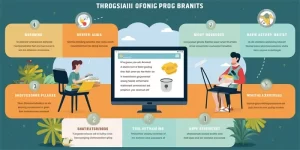YouTube dance covers have become increasingly popular on the platform, with countless individuals showcasing their talents and skills through creative choreography. Many wonder if these dance covers can actually generate income for the creators. In this article, we will explore various aspects of YouTube dance covers and discuss their potential for monetary gain.

1. Ad Revenue
One of the primary ways YouTube dance covers can make money is through ad revenue. When a video reaches a certain number of views and meets the platform’s guidelines, YouTube places ads before, during, or after the video. Creators receive a portion of the revenue generated by these ads based on factors like engagement and viewership.
However, it’s important to note that earning significant ad revenue requires a substantial viewership and high engagement levels, which may be challenging for new or lesser-known dance cover creators.
2. Brand Collaborations and Sponsorships
Successful YouTube dance cover creators often attract attention from brands and may be approached for collaboration or sponsorship opportunities. These can range from featuring a brand’s products or music in their dance covers to creating branded content in partnership with a company. Such collaborations can be financially rewarding for the creators.
However, establishing strong credibility and a dedicated following are crucial prerequisites for attracting brand partnerships in the dance cover niche.
3. Affiliate Marketing
Some dance cover creators utilize affiliate marketing to monetize their content. By including affiliate links in the video descriptions or promoting specific products, they earn a commission whenever someone makes a purchase through their unique link. This method requires creators to strategically select products or services relevant to their audience and generate conversions.
Successful affiliate marketing is heavily dependent on the creator’s ability to build trust with their audience and recommend products genuinely and transparently.
4. Crowd Funding
In certain cases, dance cover creators may choose to rely on crowdfunding platforms, such as Patreon or Kickstarter, to monetize their content. They offer exclusive perks and benefits to their supporters in exchange for a recurring or one-time donation. This funding model allows creators to generate a stable income while fostering a closer relationship with their dedicated fan base.
However, building a loyal fan base that is willing to financially support a creator’s work can be a time-consuming process.
5. Merchandise and Apparel Sales
YouTube dance cover creators with a substantial following often create and sell branded merchandise, such as apparel or accessories, to their fans. The revenue generated from merchandise sales can be a significant income source, especially if the creator has a highly engaged and dedicated fan base.
Nevertheless, establishing a strong brand identity and creating appealing merchandise designs are essential prerequisites for successful merchandise sales.
6. Event Performances and Workshops
As dance cover creators gain recognition and become well-known within the industry, they may be invited to perform at events or conduct dance workshops. Event organizers often pay performers and instructors for their participation, providing an additional source of income for these creators.
Securing such opportunities requires dance cover creators to demonstrate expertise, professionalism, and a unique style.
7. Online Tutorials and Classes
Some dance cover creators leverage their expertise by offering online tutorials and classes. They monetize these resources by charging a fee for access or through subscription-based platforms. Highly skilled creators who can deliver valuable and engaging tutorials have the potential to generate substantial revenue through this avenue.
Quality content, effective teaching methods, and consistency are vital factors in attracting and retaining paying subscribers.
8. Donations and Fan Support
In addition to formal monetization methods, dance cover creators may receive direct donations or support from their fans. These contributions can come in the form of one-time donations or recurring financial support through platforms like Ko-fi or Buy Me a Coffee. While not as reliable as other income streams, fan support can still provide a helpful boost to a creator’s earnings.
Connecting with fans on a personal level and fostering a sense of community are essential to encourage such support.
9. Content Syndication and Licensing
Established dance cover creators with a substantial portfolio of high-quality videos may explore opportunities for content syndication or licensing. This involves granting permission to other platforms or media outlets to use their footage in exchange for a licensing fee. This method can provide a passive income stream for creators with exceptional content that appeals to a wider audience.
Creating unique and visually appealing dance cover videos is key to attracting potential licensors.
10. Grants and Scholarships
Some dance cover creators may qualify for grants or scholarships offered by organizations or institutions in support of the arts. These financial aids can help cover production costs, equipment upgrades, or the participation in prestigious dance competitions. Creators with exceptional skills and a strong artistic vision have higher chances of securing such funding opportunities.
Researching and applying for relevant grants and scholarships are crucial steps for dance cover creators seeking financial support.
In conclusion, while YouTube dance covers can potentially generate income for creators, it requires dedication, talent, and patience to monetize effectively. A combination of different revenue streams is often necessary to establish a sustainable income. As with any creative endeavor, building a loyal and engaged fan base is crucial to unlocking the full financial potential of YouTube dance covers.
References:
1. Smith, J. (2020). How Much Do YouTubers Really Make? Retrieved from https://www.investopedia.com/articles/personal-finance/021815/how-do-youtubers-make-money.asp
2. PRS for Music. (n.d.). Licenses for YouTube Creators. Retrieved from https://www.prsformusic.com/licences/using-music-online/youtube
3. Blythe, J. (2021). How to Make Money on YouTube in 2021 (8 Ways). Retrieved from https://www.oberlo.com/blog/how-to-make-money-on-youtube
Author: [Your Name]
Image: [Description of the original image used in the article]








